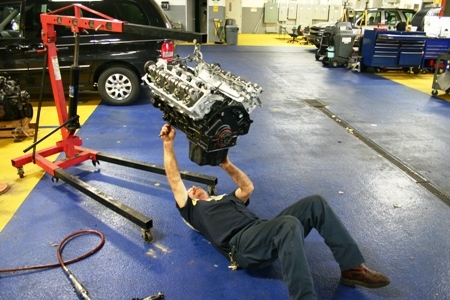Auto Repair National Safety Awareness Day
February 20, 2010 5:42 pm Apprentice Tech“I’m gonna change this oil pan if it Kills Me!”
Summary: Having the right tools for the job not only increases production, it can help prevent personal injury. The auto mechanic in the picture above risks life and limb to change over an oil pan to a newly rebuilt engine. Technicians that have been working on cars for years are not exempt from making rookie mistakes. In fact older auto tech’s with more years in the field, may be more prone to taking some risks simply because of complacency.
Ok, here’s the sales pitch. In the market for an engine stand? It could be a real lifesaver! Kidding aside, safety is no laughing matter. In fact DenLor’s is proclaiming February 20th “Auto Repair National Safety Awareness Day.” In checking with the United States Department of Labor, I’ve found that auto mechanics are statistically more likely than the average worker to be injured or killed on the job. Working on a crab fishing boat in Alaska is definitely more risky, but mechanics are exposed to risk too. Over the years I’ve never had a car fall off the vehicle lift, but I have heard of a few falling. The worst injury I’ve ever had working in an auto repair shop was when I was changing a tire that had been ran flat; the tire was nearly disintegrated. The only part that was remaining was a couple of inches of the sidewall and both beads. The tread and most of the sidewall was GONE. So, fifteen minutes before my lunch break, I had to change one tire. No problem normally, however this tire was much more difficult to change. The tire machine’s bead breaker didn’t have much to push on. This was back in the 80’s and the tire machine was the old Coats style with a bead breaker on the bottom and one on top that swings over. I was reaching under the tire with my left hand pulling up on the bead while I worked the foot pedal for the bead breaker. I had my hand too close to the bottom bead breaker and you could guess what happened next… it slipped off the bead crushing the tip of my middle finger. I instinctively yanked my hand back pulling the cap of my finger off, including the fingernail and surrounding skin. With my crushed bloody finger I told my boss at the time (Bill Harper Dade City Goodyear Mgr.) who was pulling a car into the shop that “I was injured.” He said are you going? I said yeah, with that I ran about a block over to the walk-in clinic. The pain of disinfecting it was worse than the what the tire machine had inflicted! After it was cleaned they injected a pain-killer and put stitches completely through my finger to hold it together. Luckily the nail bed was not damaged too bad. The nail grew back almost completely normal.
Quote from a US Dept. of Labor Study
Mechanics are more likely than the average worker to be injured or killed on the job, as evidenced by higher rates of fatalities and injuries and illnesses. For both fatal and nonfatal injuries, contact with objects and equipment, such as parts and materials and vehicles, represents a significant hazard. Many of the remaining nonfatal cases are due to overexertion and sprains and strains.
Tips for Working on Cars Safely
- Use common sense, if you have second thoughts about how you are doing a certain procedure – reconsider how it can be done more safely.
- Avoid defeating safety devices on equipment. Safety devices on vehicle lifts are there for a reason – it is also an OSHA violation to defeat them.
- Use safety glasses when grinding, using power tools, air tools, hammers or anything else that may cause harm to your eyes. I once knew of a service manager that was helping a tech, using a pry bar. The bar slipped and the technicians eye was hit -Â now he has one eye.
- Use jack stands. Don’t trust your life to ANY floor jack. Someone I used to work with had a close call, when changing a starter on his own car at home. The floor jack leaked slowly and he was pinned! Lucky for him a friend came by to save the day. A jack stand in place would have prevented him from nearly suffocating.
- Consider the vehicles balance on a lift when removing heavy component like an engine or transmission. I removed an engine from an extended cab F150 and nearly had the truck fall backwards off the lift. Between the length of the truck and the weight being removed in front, the truck became heavier at the rear and teetered slightly backwards. I was fortunate to be able to let the vehicle down without incident.
- Use gloves to reduce your skin’s exposure to chemicals. Reduce the use of spray chemicals like brake clean when possible. Livers and lungs pay the price over time for over-exposure to chemicals.
- Finally, use an engine stand to safely transfer parts when changing engines. Never get underneath an engine supported by just an engine crane/hoist. If the chain let’s go on either end, 3-400 pounds will be coming your way!

Anna Ashmore :
Date: March 1, 2010 @ 7:20 am
🙂 Nice Reading. Thanks
The smile says it all! Visit us for specialized Auto Repair in Houston.